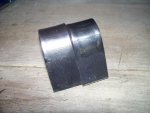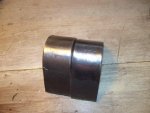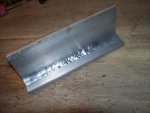B.M.800
TheBeal.
So Ive been going to Voteck welding. Im enjoying it for the most part. I do not enjoy however the AM class. Half of them are morons... to put it politely. 
These pieces are made from 2 3/8in 7in long X about 3in cut with an included angle of about 45*. 22.2* on each piece. They are set to a 1/4in backing bar with a gap approximately 1/4in -/+ 1/16in.
When it is tacked together, it is welded using SMAW, or stick welding in the the 3g position, otherwise know as vertical up. I used 3/32 7018 at about 94-98 amps.
I believe we are allowed up to 1/8in inclusion and still pass for certification.
The piece on the left is the Root bend, you can see 2 small boogers, I believe they are from small amount of slag where there was a gap between the 3/8in plate and backing bar. The bend was slightly off center, but it still would pass.
The other piece, the Face bend you can see right in the middle is where I didnt grind down quite far enough. It actually looks worse than it really is, when it was bent it makes the welds more pronounced. Instead of it being smooth like when it was ground down, you can actually feel the weld beads.
Hopefully, I can do this again when it comes test time. ...and hopefully i got all my facts right up there lol
This coming week I will start over again, but this tin in the 4G, or overhead position.
These pieces are made from 2 3/8in 7in long X about 3in cut with an included angle of about 45*. 22.2* on each piece. They are set to a 1/4in backing bar with a gap approximately 1/4in -/+ 1/16in.
When it is tacked together, it is welded using SMAW, or stick welding in the the 3g position, otherwise know as vertical up. I used 3/32 7018 at about 94-98 amps.
I believe we are allowed up to 1/8in inclusion and still pass for certification.
The piece on the left is the Root bend, you can see 2 small boogers, I believe they are from small amount of slag where there was a gap between the 3/8in plate and backing bar. The bend was slightly off center, but it still would pass.
The other piece, the Face bend you can see right in the middle is where I didnt grind down quite far enough. It actually looks worse than it really is, when it was bent it makes the welds more pronounced. Instead of it being smooth like when it was ground down, you can actually feel the weld beads.
Hopefully, I can do this again when it comes test time. ...and hopefully i got all my facts right up there lol
This coming week I will start over again, but this tin in the 4G, or overhead position.






